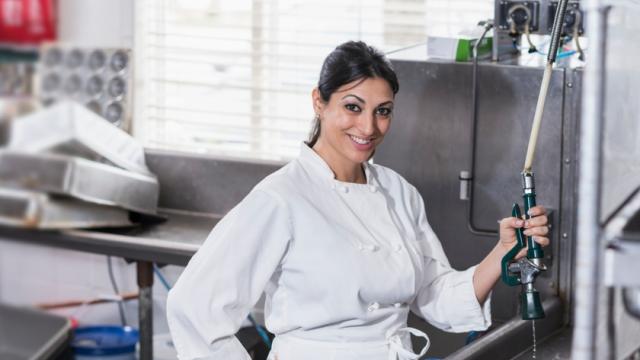Foodservice facilities use a lot water for cooking, washing dishes, making ice and other important functions. Although critical to your operations, that water use can make quite a splash on your budget. Fortunately, there are a variety of operational and maintenance measures, as well as cost-effective upgrades that can help you reduce water use, as well as the energy used to heat that water.
Cooking Equipment
• Load steam cookers, steam kettles, and combination ovens to capacity — only use as many compartments as needed.
• Keep doors closed and lids secured on all steam equipment while in operation.
• Replace gaskets and tighten hinges on steam equipment doors to provide a good seal to retain heat or steam.
• Use steam and combi-mode sparingly — maximize the use of hot air or convection mode.
If you have older steam cookers or combination ovens, consider upgrading to ENERGY STAR®-certified models. ENERGY STAR steam cookers and combination ovens use less water and are more energy efficient than standard models.
Washing Dishes
• Load dishwashers to full capacity before running.
• Run dishwasher close to or at the minimum flow rate and rinse cycle time recommended by the manufacturer.
• Ensure manual fill valves close completely after the wash tank is full.
• Inspect valves and rinse nozzles regularly and repair if needed.
Replace older pre-rinse spray valves with a high-efficiency model — generally with a flow rate of 1.2 gallons-per-minute or less. Also, if you have older dishwashing equipment, upgrade to new ENERGY STAR-certified commercial dishwashers.
Food Disposal
• Hand scrape food from dishes or install food strainers, and use the scraps to compost food waste.
• Turn off water to food disposal systems during idle periods and when the kitchen is closed.
• Operate disposal systems to only run cold water to minimize hot water and energy use.
• Retrofit disposal systems with load sensors that regulates water use based on motor load, reducing idle flow rate.
Ice Machines
• Regularly clean coils on the heat exchange unit of ice machines to maintain efficiency.
• Clean ice machines periodically to remove lime and scale buildup.
• Set ice machine rinse cycles to the lowest possible frequency to provide sufficient ice quality.
• Keep lids closed to keep cool air inside ice machines and maintain appropriate temperature.
If you have a conventional water-cooled ice machine, consider replacing it with an air-cooled model. ENERGY STAR-certified air-cooled ice makers use about 15 to 25 gallons of water per 100 pounds of ice. That's at least 75% more water-efficient than water-cooled ice machines.
Around Your Facility
• Find and repair all water leaks. A single leak can waste a surprising amount of water.
• Water landscaping only early in the morning or at night.
• Adjust sprinklers so you are watering plants, not the parking lot or sidewalk.
• Install water-efficient aerators on all kitchen and restroom faucets.
Upgrade restrooms with WaterSense-labeled flushing urinals and commercial toilets. WaterSense products use less water per flush than standard units without sacrificing performance.
By taking these steps to better manage your water consumption, you can serve up plenty of savings on your utility bills. Find out more information about LADWP's Food Service Program and Water Conservation Rebate Program.
January 2024 Connections Newsletter
From industry trends and best practices to sustainability initiatives, our monthly Connections Newsletter provides valuable insights, updates, and resources to support our large business customers.
Full Newsletter